Science Outreach for the 2021-2022 Academic Year

Engagement during a second-grade Chemistry is pHun visit
ACS–St Louis Section member Joe Smith made all of this year’s presentations with scheduling and logistical help from Rockwood Partners in Education, an organization that partners with volunteers willing to share their expertise or special talents with Rockwood School District students. Giving these presentations is a fun way to share your excitement about science with students. Additional volunteers are welcome and would help ensure continuity of the “Chemistry is pHun” program. If you are interested in participating, please contact Joe at smithjp1972@gmail.com.
Second- and fifth-grade presentations both start with a brief discussion of the broad range of STEM careers and the varied settings where STEM professionals work. Safety is emphasized, with a focus on eye protection during demonstrations and on the need for adult assistance for any experiments done at home.

Solid content for Chemistry is pHun-yuns.
Fifth graders experience the “Transforming Matter” presentation, introducing the concept of a chemical reaction as a transformation that involves a change in chemical composition. Combustion illustrates how reactants can turn into products with a release of energy. Acid-base reactions are demonstrated with the help of indicators which led to an exploration, using red cabbage juice indicator, of the acidity of fluids encountered in daily life. A discussion of the pH scale ties in well with math class, where students are learning about exponents. Methods of controlling chemical reactions, such as removing a reactant or reducing temperature, are discussed in the context of extinguishing fires and the use of refrigeration to slow down food spoilage.


